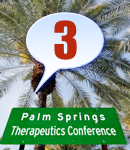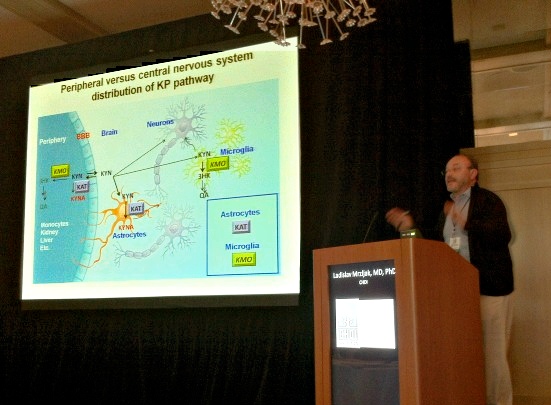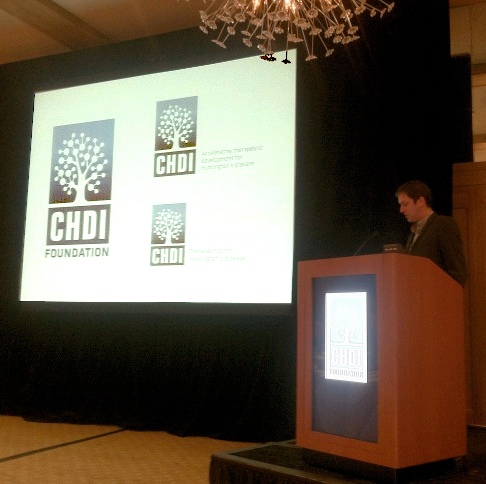
HD Therapeutics Conference 2012 Updates: Day 3
Day 3 of our coverage of the Huntington's Disease Therapeutics Conference

Our third and final daily report from the annual Huntington’s Disease Therapeutics Conference in Palm Springs, California. We will be publishing a summary article and interviews from the conference over the next few weeks.
Thursday, March 1, 2012
9:10 – Chris Schmidt works for Pfizer, a pharmaceutical giant working with CHDI to develop new HD drugs

9:23 – Schmidt: Drugs developed by Pfizer for other conditions, already tested for safety in humans, might be useful in HD
9:45 – Schmidt: Drugs that target enzymes called “phosphodiesterase” work well in healthy human volunteers, and might be useful in HD
9:59 – Vahri Beaumont of CHDI is leading the team testing Pfizer’s drugs in mouse models of HD to understand if they’re work testing in HD
10:01 – Beaumont: Brain cells in HD mice have clear changes at a very young age. Fixing these early changes is the goal of the Pfizer drugs
10:06 – Beaumont: Beautiful rescue of altered brain cell function in HD mice with Pfizer compounds – treated cells look much more normal
10:30 – Schmidt: Pfizer & CHDI planning clinical trials of PDE drugs. Preliminary work with patients hopefully 2012. HD drug trial 2013?
10:33 – Schmidt: Very early plans are being laid for a 2-year trial of a PDE-10 inhibitor drug in HD, if the work continues to go well
11:07 – Ladislav Mrzljak leads a team at CHDI developing novel drugs inhibiting “KMO”, see our KMO inhibitor article for why this is good thing
11:14 – Mrzljak: KMO inhibiting drugs might be able to take advantage of cross-talk between brain and immune system
11:38 – Mrzljak: CHDI’s top KMO-inhibition drug candidate is called CHDI-246. It performs well in lab tests of desirable chemical activity
11:41 – Mrzljak: studies of CHDI-246 are already underway in two mouse models and one rat model of Huntington’s disease. Studying drugs in multiple mouse models helps prevent ‘false positive’ results to make sure only the best drugs reach human trials
12:01 – Graham Bilbe works for drug giant Novartis who are testing a drug called Mavoglurant that blocks receptors for the brain transmitter glutamate
12:04 – Bilbe: sometimes decades of work are required to prove that a drug is worth testing in people
12:07 – Bilbe: overactivity of the glutamate system has been suggested to be involved in many diseases
12:13 – Bilbe: From the unwanted movements that Parkinson’s drugs can cause, Novartis got the idea that glutamate blockers might work in HD
“A lack of basic understanding is no longer the limiting factor in finding treatments for HD”
12:16 – Bilbe: Mavoglurant produced benefits in a small Parkinson’s disease study, and is moving into larger trials
12:27 – Bilbe: Novartis’ trial of Mavoglurant for HD movement symptoms has just finished, and the data are being analysed right now
14:14 – CHDI has hired Christina Sampaio as chief clinical officer – good news because she has lots of experience with drug trials
14:18 – Sampaio: to succeed in developing drugs for HD we need to close chapters, and not repeat trials with failed drugs
14:21 – Sampaio: We shouldn’t try to run the longest, biggest, trials we can, but smart trials
14:41 – Sampaio: Other disease are contributing to HD – RNAi trials in Duchenne Muscular Dystrophy help us learn about the technique
14:48 – Sampaio: forthcoming trials will likely focus on people with HD symptoms because that’s where treatment success can be measured.
14:50 – Sampaio: if other diseases are anything to go by, we may need several treatments to tackle HD. MANY approaches are being tested!
14:57 – Sarah Tabrizi (University College London) and her team have wrapped up the observational TRACK-HD trial, which was planned to run for 3 years
14:58 – Tabrizi: “A lack of basic understanding is no longer the limiting factor in finding treatments for HD”
15:18 – Tabrizi: changes in the brain seen with MRI can predict whether someone will go on to develop symptoms – trials should include MRI
15:25 – Tabrizi: The 3 year data from participants in TRACK-HD is hot off the presses and reveals changes that could be used in HD trials
15:29 – Tabrizi: Despite changes in the brains of people carrying HD mutations, they are able to compensate and act quite normally for years
15:37 – Tabrizi: A new study, TrackOn>HD, will try to understand how the brains of people with HD mutations compensate after loss
16:10 – Mark Guttman (Centre for Movement Disorders) asks the provocative question – “when do HD symptoms start?”

16:24 – Guttman: Doctors diagnose ‘HD onset’ based on abnormal movements. It’s often difficult to be sure; uncertainty can be very worrying. Many HD-affected people and families report a ‘spectrum’ of symptoms before ‘official’ diagnosis.
16:37 – Guttman asks whether we should make this spectrum part of the diagnostic criteria, including things like MRI scans. One advantage of this may enable earlier treatment – if we can come up with drugs that work
16:40 – Guttman: A group of clinicians, scientists and patient representatives is working to examine this possibility
16:58 – Michael Hayden (University of British Columbia): many new HD genetic diagnoses are now made in people over the age of 60. Many people don’t know they are at risk.
16:59 – Hayden: Because of increasing life expectancy, people who would previously have died of old age may now live long enough to get HD
17:00 – Prevalence is the name scientists use for how many people are affected by a condition at any time.
17:01 – Hayden: The true prevalence of Huntington’s is probably much higher than previously thought
17:03 – Hayden: increasing awareness of HD has also brought more HD-affected people to medical attention
17:05 – Hayden: thorough search in British Columbia reveals the prevalence is twice as high as previously thought – at least 1 in 6,800
17:06 – Hayden: That means that as many as one in a thousand people in BC is at 25 or 50% risk
17:16 – Hayden: these changes will require us to get better at diagnosing HD and mean that more funding for HD care is needed.
17:42 – Simon Noble unveils CHDI’s logo- a tree made of molecules, representing HD families, connectedness and drugs!
18:02 – HDBuzz editors Jeff and Ed are describing HDBuzz to the therapeutic conference as we write
Learn more
For more information about our disclosure policy see our FAQ…


